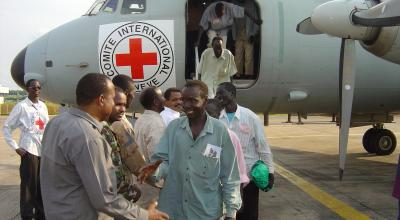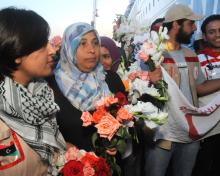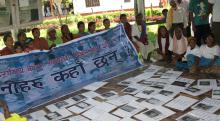Case prepared by Pierpaolo Castiglioni, Yiota Constantinidi, Fiammetta Ferioli, LL.M. students at Roma Tre University under the supervision of Giulio Bartolini (Professor) and Tommaso Natoli (Research assistant), Roma Tre University IHL Legal Clinic; with the contribution of Jemma Arman and Isabelle Gallino, LL.M. students at the Geneva Academy.
A. THE JUSTICE AND EQUALITY MOVEMENT PROMISES TO RELEASE DETAINEES AT THE REQUEST OF A RELIGIOUS LEADER
August 28, 2016 (KHARTOUM) - The leader of the Justice and Equality Movement (JEM) Gibril Ibrahim has promised to release Prisoners of War (POWs) from government forces at the request of a Sufi Islamic cleric.
On 10 August, the leader of the Kabashi Sufi sect Abdel-Wahab al-Khalifa al-Hibir al-Kabashi sent a letter to JEM’s leader appealing to him to release government POWs.
In a letter he wrote in response to al-Kbashi’s message, Ibrahim said he appreciates the latter’s request, pointing [sic] the religious leader and the POWs families would soon hear good news in this regard.
According to the political advisor of the (JEM-Dabago), a breakaway group from JEM, Nahar Osman Nahar, more than 100 POWs and detainees are currently being held in JEM’s prisons including former members of the executive office and commanders from the movement such as Hashim Haroun besides other civilian detainees.
He told Sudan Tribune that nine detainees from JEM-Dabago are still detained by JEM after 9 others managed to flee from the movement’s prisons in Deim Zubeir Camp in Western Bahr el Ghazal region, South Sudan.
For his part, JEM-Dabago leading figure Issa Mohamed Issa said that JEM currently detains 48 people besides a similar number of POWs from the Sudanese army.
Issa, who escaped from JEM prisons in South Sudan, added the movement had more than once in the past released government POWs through the International Committee of the Red Cross (ICRC).
He called upon the humanitarian groups and the international community to check on the conditions of the detainees at JEM prisons. […]
B. RELEASE OF DETAINEES BY THE JUSTICE AND EQUALITY MOVEMENT
October 16, 2016 (KHARTOUM) - Leader of the rebel Justice and Equality Movement (JEM) Gibril Ibrahim said they have released all detainees and Prisoners of War (POWs) from the government army and breakaway factions pointing [sic] they are waiting for the Red Cross to transfer them to their families.
Last month, JEM announced the release of all detainees and POWs from government forces in response to appeals from religious leaders, civil society organizations and prestigious national figures.
Ibrahim told Sudan Tribune on Saturday in Paris that they have “released all government POWs and pardoned JEM defectors who were tried for high treason”.
“We went to the Red Cross and handed them the issue and they are making arrangements to issue permissions from various governments … they are now on this stage and we hope they complete their procedures … we wish the POWs arrive to their families,” he added.
He stressed that his movement is committed to its pledge regarding the release of the POWs, saying this obligation is “irreversible”. [N.B.: JEM-Dabajo signed a peace agreement with the Sudanese government in Doha, in February 2013. See also Sudan, Release of Child Soldiers]
It is noteworthy that several JEM defectors have been detained by the movement since three years ago. […]
C. UGANDA OVERSEES THE RELEASE OF DETAINEES BY THE SPLM-NORTH
President [of Uganda] Yoweri Museveni has overseen the safe handover of 125 Sudanese prisoners of war, to the Khatoum [sic] Government, who had been previously captured by the Sudan People’s Liberation Movement-North rebel fighters.
Speaking before the former captives and a high profile delegation at State House, Entebbe, yesterday, the President expressed gratitude to both the Government of Sudan (Khartoum) for accepting the prisoners of war and to the SPLM-North for exhibiting the peace gesture.
“There are certain governments that never allow to receive such prisoners of war but for this case, the government of General Bashir has,” President Museveni said.
President Museveni commended the SPLM-North for not killing the captives. He said such acts of killing captives strengthen the enemy instead, because it discourages the others from surrendering.
“Why would you kill a soldier who is already injured? The fact that you say that you do not kill the prisoners of war, means Garang listened to my lessons,” Mr. Museveni added. The late John Garang was a Sudanese politician and leader, who, from 1983 to 2005, led the Sudan People’s Liberation Army/Movement [(SPLA/M)] during the 2nd Sudanese Civil War. Following a peace agreement between the Khartoum-based Government of Sudan and the SPLA/M, Garang served briefly as the 1st Vice-President of Sudan from July 9th 2005 until he died in a helicopter crash on 30th July 2005.
The group of the former prisoners of war was released through Uganda because President Museveni was instrumental in negotiating for their freedom in an ongoing effort to usher in peace through engaging the Sudan Government (Khartoum), the SPLM-North, and the Darfur rebel fighters. […]
According to the SPLM-North, they agreed to the release of all the prisoners of war under an operation code-named “Good Intentions” which the representative of the Sudan government, Tarig Sayed Ali, the Secretary General of Patriot Tribes affirmed that it was unconditional.
The released started arriving in Uganda last Thursday after being in captivity for 6 years. The former captives hailed President Museveni for their freedom urging him to continue with the Pan-African spirit to ensure that the entire African continent is peaceful.
“I want to thank God that we are now free after all those years. We will never forget this effort of the people of Uganda and President Museveni,” said Colonel Richard Abdalla, a former prisoner of war. […]
SPLM-N was formed primarily by South Sudanese, Sudan People’s Liberation Movement/Army, that remained in Sudan following the South Sudanese vote for independence in 2011. They have been engaged in violent conflicts with Sudanese army since 2011.
Discussion
I. Classification of the Situation and Applicable Law
1. How would you classify the situation between the JEM and the Government of Sudan? What about the situation between SPLM-North and the Government of Sudan? Does the fact that SPLM-North is composed of South Sudanese influence the classification of the conflict? What criteria must be fulfilled to classify the conflict as a non-international armed conflict? (
GC I-IV, Art. 3;
P II, Art. 1)
2. Would Additional Protocol II be applicable to the situation? Why? (
P II, Art. 1)
II. Release of Detainees
3. Is there a legal basis for detention in a non-international armed conflict? If yes, where can it be found? Why would Sudan need a legal basis in international law to detain persons on its territory? (
GC I-IV, Art. 3;
P II, Art. 5;
CIHL, Rule 128)
4. What is the status of the persons who were detained and subsequently released by the JEM and the SPLM-North? Can there be POWs in a non-international armed conflict? Can armed groups decide to grant POW status to persons they detain? (
GC I-IV, Art. 3)
6. When shall persons deprived of their liberty in a non-international armed conflict be released? Is there an exception to this rule? (
CIHL, Rule 128C)
III. Elements Contributing to Respect for IHL
7. (Documents A and B) What brought the leader of the JEM to release the persons? Who appealed to him? In your opinion, how much of an impact can civil society and the international community have in such circumstances? What impact may religious leaders have towards respect for IHL?
8. (Document D) Why does the President of Uganda affirm that killing the captives does not weaken, but rather “strengthen the enemy”? Do you agree?
9. In your opinion, why did Uganda agree to act as an intermediary between the Government of Sudan and the SPLM-North? How helpful can it be to have such an intermediary when it comes to the release of detainees? Are such intermediaries envisaged under IHL? In non-international armed conflicts? In international armed conflicts?
10. SPLM-North called the operation of release “Good Intentions” and affirm that this was “unconditional”. What does the very code-name of the operation imply about the objectives of the group? How do you think this act will be perceived by the Sudanese people?






